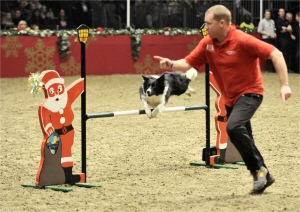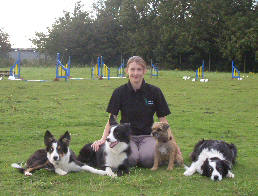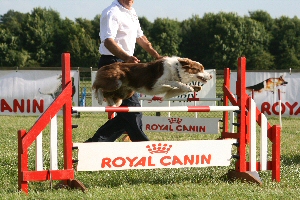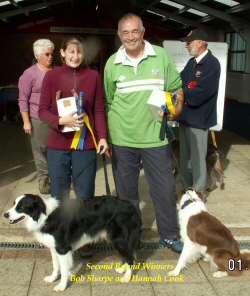Where agility dreams come true
 Bob
Sharpe is well known to his fast growing band of club members and regular readers of The
Voice as a man who is not afraid to speak his mind on subjects to do with his beloved
Agility. Soraya Porter tracked him down to a training field in deepest, darkest Dereham - bow
and arrow country to many of us - where he trains a ‘splinter group' of his Field of Dreams to
find out more about his personal agility career. Bob
Sharpe is well known to his fast growing band of club members and regular readers of The
Voice as a man who is not afraid to speak his mind on subjects to do with his beloved
Agility. Soraya Porter tracked him down to a training field in deepest, darkest Dereham - bow
and arrow country to many of us - where he trains a ‘splinter group' of his Field of Dreams to
find out more about his personal agility career.
Q. When and how did you first get
involved in dog agility?
I had
always had a pet collie since my early 20s but when I was in my 40s I had kidney failure so
it restricted my activities with them. I had a transplant in 1999, and I then bought Skip, a
blue merle with the sole aim of having company as I travelled the cricket fields of Yorkshire
watching my son develop into a much better player than I ever was.
 My
wife Pauline took Skip to Scunthorpe on a wet and windy night for an eight week agility class
where the first exercise set was to jump a line of four on the lead. I am not sure how this
was supposed to be accomplished. She managed two. Skip got in front, and clinging for dear
life she was dragged under the last two, still holding the lead. My
wife Pauline took Skip to Scunthorpe on a wet and windy night for an eight week agility class
where the first exercise set was to jump a line of four on the lead. I am not sure how this
was supposed to be accomplished. She managed two. Skip got in front, and clinging for dear
life she was dragged under the last two, still holding the lead.
The
following session brought more of the same with the reluctant Skip disappearing under the car
upon completion of each exercise. My wife was on holiday the following week and, as the money
had been paid, the substitute awaited his turn behind a young girl, Hannah Cook and her
handsome Josh. I did okay. The competitive instinct, honed on the playing fields of South
Yorkshire, stood me in good stead. Apparently Skip worked better for me, and a potential new
recruit to the sport was discovered. I doubt though that anyone saw two future Advanced
handlers following each other round the course that night.
Q. When did you realize you were hooked
on agility?
As I
explained, my role at this stage of my life was to chauffer to my son, who was then
progressing through the county youth cricket structure, and playing in a semi-professional
league around South Yorkshire. As we now lived in North Lincolnshire, the only means of
transport was Dad, and we both existed for the Saturday afternoon league, and Sunday
representative matches.
 I
still trained once a week with Skip and enjoyed the bond I had with him. I got a little
better and entered my first show in April. The Cricket season was a few weeks away. Skip got
a clear in his first run, finishing 30th. I then went to Otley where he won out of
Starters and had clear rounds in Team and Pairs, too. I
still trained once a week with Skip and enjoyed the bond I had with him. I got a little
better and entered my first show in April. The Cricket season was a few weeks away. Skip got
a clear in his first run, finishing 30th. I then went to Otley where he won out of
Starters and had clear rounds in Team and Pairs, too.
I was
not hooked yet. Agility was something girls did, and the visions of cold beer,
sunshine and male bonding amid the mining villages still held sway. I could never envisage
not watching cricket, but the hook was planted and I found myself leaving Tim with teammates
on the Friday, competing Saturday and returning from various parts of the country to collect
him from Sheffield late that night.
Later
that season I missed a championship decider. Tim took seven wickets and was Man of the Match.
Flynn had his first novice win and visions of Crufts overshadowed Lords for the first time.
Sometime between then and the start of the next season the addiction took hold and Tim took
driving lessons.
Q. Tell us about your early training
problems, and early days in the sport
Lack of
support was the main obstacle, and looking back I realise how determined we must have been to
overcome all the barriers we had to deal with from people who should have been encouraging
our ambitions. Scunthorpe allowed members to train once a week. Only by offering to run a
training night did I get access to a further session. There was, however, a catch to this
concession in that we had to arrive 30 minutes after the session began and use only the
equipment available at that time which was not needed by the current class.
Our
first session under these limitations saw four old jumps left for our use. We took three
plus my weaves, and practiced 100 metres away. Over the coming months we developed an
ingenuity for producing three jump exercises that have served me well to this day.
The only
contact equipment available was an aged A-frame which must have been hewn from Robin Hood's
Oak as it was so heavy. Somehow we carried it the 100 metres to our distant outpost and back
again in the dark. Fortunately, I had just started private lessons with Greg so we had a
system to work with and our handling developed from these limited beginnings.
Q. Who were your first great influences
in agility.
Jo
Rhodes was the first guest trainer I worked with at Scunthorpe and I swore I would never do a
front cross - twizzle as it was known as then - because it was effeminate. Looking back I
learnt very little as I was clueless, but I struck up a relationship with her then that has
lasted to this day. I always value her advice. She calls me the 'old man' and I call her a
'has been' but I think she is a brilliantly innovative handler, and she has helped in lots of
little ways over the years.
At
Scunthorpe, the only establishment member who offered any help was Lisa Adamson. Knowing her
as I do now, I guess the reason for her sole support in the presence of much opposition, was
because she saw a lot of her determination in me. She is now a continual reminder of how not
to do it, but we still train together and, despite some very vocal differences of opinion
recently, she remains, I hope, a good friend.
 Q.
Who would you say were your major influences now in the sport. Q.
Who would you say were your major influences now in the sport.
Apart
from Jo's initial contribution and occasional tips, the sole influence has been and still is,
Greg Derrett. I unashamedly use and teach his style of handling although he may contend that
my execution is anything but his style. I have followed his methods for over five years now,
have trained on average twice a month with him and put any success I have had firmly on his
shoulders.
On a
day-to-day basis I also rely on Hannah to keep me in check and remind me on a regular basis
that 'I am not Greg Derrett' when I attempt some unrealistic fleet footed move. She must have
watched over 90% of all my runs, and knows my game intimately, quickly spotting any
detrimental changes and not hesitating to remind me of them, often at the most inappropriate
times. I must have masochistic tendencies though, as I can remember every one of the five
times Greg has praised me in the last five years. I can also recall the three instances when
Hannah thought I warranted favourable comment.
Q. Have you ever been tempted to run any
other size of dog in agility?
No! You have to run faster with the smaller dogs. All my
dogs are pets primarily, and the breed suits me. It's probably my male ego, but I don't feel
that I would look right with a poodle and running a Medium collie against the Jack Russells
and Patterdales seems unfair, but that is no criticism of those talented handlers that do.
Q. Do you think all three sizes of dog
are treated equally?
I assume
you mean with regards to opportunity to be competitive? I have very little experience of any
other size other than training them, so it is difficult to make a decision. It's down to
supply and demand really. If you have relatively few dogs and handlers at this size, then
shows are going to struggle to put on suitably graded classes and, if they do, should a win
with the only clear round in a class of three really warrant progression?
My views
regarding the jealous minority in Medium has been well covered in The Voice. I do feel
that anyone with a Medium collie has a distinct advantage over a Staffie owner for example,
but as the rules are currently it's fair and how do we change it? Do we exclude small
Kelpies, too? They are also quick and win classes.
If some
participants were to get their way, we would be having classes just for Spaniels. And if they
still could not win they would seek rule changes limiting it to Spaniels within a 30 mile
radius of Stoke, reduce the jump height again, exclude the Grade 6 & 7 ones, and still expect
the winners to go to Olympia. In all sports there are winners and losers. Why should agility
be any different?
Q. Is there anything in particular that
you now know, that you wish you had been told when you first started in the sport?
Greg's phone number.
Q. Have there been any turning points in
your career – 'light bulb' moments so to speak?
Not
really, it's been a gradual process. I did have problems rear crossing and a session with Jo
Rhodes highlighted the advantages of setting your line early and solved a continual problem I
was having but that's all.
Q. As well as competing, you judge and
teach agility. How do you think these experiences have influenced how you run your dogs ?
I don't
judge too often - typically 3-4 times per annum - and I don't think this affects anything.
Reminding people of the need to be consistent and to maintain criteria in training means that
I have to do the same when competing, and this certainly helps me to focus on the basics more
than I perhaps would otherwise in competition.
 Q.
Can you tell us something about your current dogs please? Q.
Can you tell us something about your current dogs please?
I
currently run Meg at G7 and Flynn at G6. I am also training Blaze who is 16 months old and
expected to begin his career next March/April. The latter two are from the Sherebridge line
in Darlington, as is my wife's three year old Moss.
Flynn is
very headstrong and driven but realistically he was one dog too early for me as I have not
developed his undoubted natural ability as well as I should have done. I did not have the
training knowledge then that I have now, and I feel that I have let him down a little. He,
however, does not know this and greets each run as enthusiastically as ever and is very
competitive in his grade.
Meg was
five in June and has taken me to the unimagined heights of G7. She was given to us as a very
nervous ten month old girl. She had been bullied by her housemates and almost run over twice
trying to escape. She had never played or had 1 -2- 1attention. My wife Pauline spent a lot
of special time with her. Once Meg had the confidence, she adapted well to agility, but we
never expected her to achieve what she has. Undoubtedly daddy's little girl, my start line
set up always includes a kiss to her and she still brings a lump to my throat when I think of
her frightened beginnings.
Blaze is
the first dog of mine trained using knowledge gained from Susan Garrett seminars so his
development will be of particular interest. He has adapted to quite complicated sequencing
quicker than any of my dogs as have others of a similar age who have trained with him using
these methods. It will be an interesting season next year.
|
Q. You have recently set up your
own training school Field of Dreams. Can you tell us what made you decide to branch out
from freelance instructing?
There was no conscious decision. I did a bit of work at club venues when asked but always
wanted some land to train myself. A field became available which, at the time, was a
little larger than I needed. I sought to supplement our private use with some income from
a few people we had trained regularly.
As I
debated whether I could afford the outlay, the haunting words from the Kevin Costner film
replayed in my brain 'build it and they will come' - so we did and they
came. The name of the club comes from the film title Field of Dreams.
I
train either privately or in class situations there most days, helped by Hannah and
Becky.
 I
still travel quite extensively as I feel it's important to reach as many people as
possible if you are to develop your business, so at the moment I have a happy balance
between the two and a superb back up from my wife Pauline when I stretch myself a little
thinly. I
still travel quite extensively as I feel it's important to reach as many people as
possible if you are to develop your business, so at the moment I have a happy balance
between the two and a superb back up from my wife Pauline when I stretch myself a little
thinly.
Q. Can you tell us about any goals
that you have set yourself. Are these more long term or immediate?
I
try to set achievable and measurable goals so most are short term but stretch little
beyond. I try my best to achieve the best partnership I can from each dog I run. I
would love to get to Olympia, though I doubt I will ever get a better chance than this
year when I failed in the Semi. Crufts holds no attraction. Meg was brilliant on the
carpet last year, but I hate the dog unfriendliness of the place and 'jobs worth'
security staff.
|
The Dream
Team

Hannah |
|

Becky |
My main
goals now are to help my pupils achieve their goals. At the moment four people whom I train,
or train with have qualified for the two events. I get as much pleasure out of their
successes as any of my own.
 Q.
Do you suffer from competition nerves? And if so, how do you cope with them? Q.
Do you suffer from competition nerves? And if so, how do you cope with them?
I think
anyone who is serious about doing well in any discipline has nerves of some form - it's part
of any competitive sport - but as for the stomach churning type, the only time I feel
anything remotely like this is in a Team situation or particularly in Pairs classes. I played
cricket at a good level and experience of many years competition there must have helped. You
are either good enough or not. What is the worst thing that can happen? You get hit for four
or you drop a pole. No one dies.
If it's
a weakness exposed, go away and come back better prepared. If you are beaten by a better man
keep doing what you are doing, it will be your turn next. My view is that I have prepared to
succeed, so much is under your own control and there should be no surprises, but this is a
sport and anything can happen. With Team and Pairs, I take it personally if I let the others
down and this does produce a different feeling on the line. Fortunately I have always run
with sympathetic partners and adopt the same attitude to them.
Q. Do you have a particular routine you
follow when competing?
I always
give my dogs time on the exercise area before their first run, firstly to release some of the
excess energy, then practice a few waits just to exert some control. I will then release a
few times, replicating the start they will face in the 1st class. I always try to
make this one count as it sets the tone for the day but otherwise, I don't do anything
special.
 Q.
Do you prepare yourself differently if it's a competition final? Q.
Do you prepare yourself differently if it's a competition final?
I have
not been good enough to reach any of the majors but with the important runs, I will spend
more time watching how the course runs, then concentrate on visualising my round. I always
carry Meg to the line, give her a kiss and tell her to go clear. Sometimes she listens, but
this routine seems to dispel any nerves I have. Other than that I think I am just a little
quieter and more focused than on the everyday runs.
Q. People watching an experienced handler
often comment on how easy they make it look. Would you say you were still learning and do you
have any major issues you are working on at the moment?
If you
stop learning, you stop improving and when that happens forget being competitive. My knees
limit me to the amount of time I can train but I try to work at full speed once a week with
Hannah, where we will concentrate on a specific weakness that we have highlighted, or new
moves we want to try.
At the
moment, I am trying to get my timing right with Meg as she is so unforgiving of anything less
than perfection. Apart from that, it's just repeating the basics, particularly reinforcing
contact criteria which has slipped slightly of late. With Blaze, I am trying a new technique
to speed up the contacts which seems to be working and, as I write, this have had him weave
on upright poles for the first time today, so only the see saw left for him.
Thanks very much
Bob for submitting so gracefully to your grilling for Agilitynet. We wish all the best for the
future - both with Field of Dreams and in competition. For more information, visit Bob's web
site
www.fieldofdreamsdogtraining.co.uk
 About
the interviewer... About
the interviewer...
Soraya Porter lives in the smallest town
in England - Manningtree, sharing her house with three Siamese cats and her dog Ernest (Hartsfern
In Earnest) who also can be heard answering to the names of Ernie, Ern, Monster, Beast and Fish
Face! Ernie runs at Grade 7, and has had many appearances at Crufts, where he is in great
demand to pose for photographs with Japanese tourists!
Currently
she trains with Bob Sharpe and at Valley Farm Agility Club, as well as doing some freelance
teaching, the odd judging appointment, designing simple agility websites, and hand spinning dog
fibre. Given such ingrained insanity, it’s a miracle that Ernie has taken part in as many
Finals as he has.
Feedback....
From
Carol Jackson...
Just read the above interview on your website, thought I’d drop you a line to say how
much I enjoyed it, particularly as I found it by chance. I’ve recently started training
(puppy class) with my cocker bitch at Bob and Pauline's club, Field of Dreams Dog Training –
it’s brilliant. I was actually looking for their website as I believe it was being
updated. I also get to read your magazine on occasions, as my agility mad friend – Veronica
Wilson – lets me borrow her copy. Interesting reading and a different point of view for
someone whose weekend reading is Dog World! (22/10/08)
Published September 2008
|  Q.
Do you suffer from competition nerves? And if so, how do you cope with them?
Q.
Do you suffer from competition nerves? And if so, how do you cope with them? Q.
Do you prepare yourself differently if it's a competition final?
Q.
Do you prepare yourself differently if it's a competition final? About
the interviewer...
About
the interviewer...